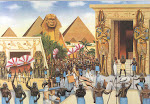Geological evidence indicates that early humans were in Egypt 700,000 years ago. To date, the oldest tools found in the lower Nile Valley have been found in and near the cliffs of Abu Simbel, just across the river from where, millennia later, the descendants of these people would build the temple of Rameses II.
"Slightly" later, dating to approximately 500,000 years ago, are various finds of stone tools, including the stone axes that the Lower Paleolithic is noted for. Gertrude Caton-Thompson and Elinor Gardner report industry in the Achulean Period (c. 250,000 - 90,000 BC) of the Lower and Middle Paleolithic.
One of the most important finds from the Achulean Period is known as Arkin 8, discovered by Polish archaeologist Waldemar Chmielewski near the the Nile Valley town of Wadi Halfa. Arkin 8, unlike many Paleolithic sites in Egypt, was not only remarkably well-preserved, but astonishingly rich. Arkin 8 boasts the earliest known house-like structures in Egypt and the Sudan, some of the oldest buildings in the world.
During the middle paleolithic period the Mousterian Pluvial allowed human culture to flourish and spread throughout the regions of northern Africa. For roughly twenty thousand years (between 50,000-30,000 years ago) our still Neanderthal ancestors developed the Aterian and Khormusan Industries which standardized the making of various tools that greatly increased the efficiency of their lives in many areas.
The Mousterian Pluvial ended a few centuries before the beginning of the Upper paleolithic period causing the dispersed African population to move closer to the Nile to escape the encrouching desert conditions of the Sahara. Most of the known data about this period comes from the archelogical site Kom Ombo located on the east bank of the Nile in the southern area of Upper Egypt. Based on the artifacts they left behing the technological developments in Kemet were not parallel with those found in Europe. While the Kemetians seemed to be behing the Europeans in the rather backward way they made burins.
However, the discovery of the Silsillian (c. 13,000 BC) effectively puts the early Kemetians back at the forefront of prehistoric technological development. Sisillian was a highly-developed microblade industry that included truncated blades, blades of unusual shapes made specifically for one task, and most significant of all, a wide variety of bladelets for mounting onto spears, darts, and arrows. There is almost no trace of earlier techniques such as Levalloisian, and Silsillian blades in some cases are thousands of years ahead of anything found in Europe from this period.
Sisillians ushered in the creation of microliths--small bladed used mostly as sickles which sets the date for dome primitive form of farming much earlier than was thought. The concentration of artifacts found in the small sites of the Halfan people gfives evidence that these early (18,000-15,000 BC) Kemetians were not wandering nomads but had sttled into more or less stable communities.
As additional evidence of the advanced nature of these prehistoric Kemetian cultures archeologist have found three Qadan cemeteries are: one at Tushka, and two at Jebel Sahaba, one on each side of the river. Along with these cemetaries is evidence of ritual burial.
Probably due to climatic conditions for some reason the Kemetians abandoned farming and herding shortly ater they were developed and returned to a nomadic hunter-gatherer culture. Fatal wounds found in a strikenly large number of the bodies in these cemetaries during the last 10,000 years of the paleolithic period suggests that these people were attacked en masse--possibly by invaders seeking to take over the regions of the Nile as the Sahara continued to succomb to aridity after the end of the Mousterian Pluvian. This is likely for throughout history scarcity haas prompted more aggressive peoples to attack andmassacre peoples who live in lands of comparative plenty.
Around 6 or 7,000 BC while the rest of the world at large was still in the darkness of primitivism, the Predynastic Kemetians were already creating a world of beauty. The periods known as the Epipaleolithic and Predynastic saw the Kemetians replacing stone tools with metal ones, tanning, decorative pottery, jewelry, weaving, carpentry and a return to settlements with farming.
This is also when they developed their spiritual beliefs in life after death as expressed by the placement of artifacts and food in tombs for the survival and comfort of the dead. Interestingly enough, the dead were buried in a fetal position facing West. This was symbolic of following the sun (Heru/karast plagirised as jesus) into the afterworld.
Thursday, 30 April 2009
Subscribe to:
Post Comments (Atom)






No comments:
Post a Comment